
Pearls have been a source of fascination for centuries. They have been considered the most magical and feminine of all gems and are the only one created by a living organism. Pearls emanate a certain warmth and glow not found in other gems, due to their unique beginnings.
Pearls are found in pearl oysters. However, the origin of the pearl mystified humans for centuries. Many theories were put forward regarding the origin of pearls however, it wasn't until the turn of the twentieth century that the relationship between pearl oysters and parasites was discovered.
Pearls were created when a foreign body of some sort, such as a grain of sand or a parasite, found its way into a pearl oyster. The oyster reacted by coating the irritant with layer upon layer of the pearly substance known as 'nacre', that gives the pearl its unique appearance and iridescent beauty. This unique relationship gave birth to the natural pearl.
Pearls are an organic gem, called organic because they are created by living creatures. Each pearl begins its existence as a piece of grit or other particle that makes its way into the shell of a marine or freshwater mollusk — types of oysters and clams. A defense mechanism kicks-in and coats the particle with layer after layer of a substance called nacre, or mother-of-pearl, which eventually becomes thick enough to form a pearl. Nacre is composed of an organic, horn-like compound called conchiolin, and calcium carbonate (CaCO3) in the form of the minerals aragonite or calcite.
Pearls are classified by their origins and their shapes.
Pearl Origin Classification
Natural Pearls
Natural pearls are formed when an accidental intruder enters a mollusk's shell and continuous layers of nacre grow like onion skins around the particle. Natural pearls vary in shape depending on the shape of the piece being coated.
Natural pearls have always been considered rare and are quite expensive. They are usually sold by carat weight. Most natural pearls on today's market are vintage pearls.
Cultured Pearls
Like natural pearls, cultured pearls grow inside of a mollusk, but with human intervention. A shell is carefully opened and an object is inserted. Shapes of objects vary, depending on the final shape of pearl that's desired.
Over time the object becomes coated with layers of nacre. The depth of the nacre coating depends on the type of mollusk involved, the water it lives in, and how long the intruder is left in place before being harvested. As nacre thickness increases, so does the quality and durability of the cultured pearl.
Cultured pearls are sold by their size in millimeters.
Saltwater Pearls
Saltwater pearls originate within a saltwater mollusk. Saltwater pearls can be either natural or cultured.
Freshwater Pearls
Freshwater pearls grow inside of a freshwater mollusk — one that lives in a river or a lake.
Pearl Shape Classifications
Spherical pearls are round, which is traditionally the most desirable shape. The rounder the pearl, the more expensive its price tag.
Symmetrical pearls include pear shaped pearls and other shapes that have symmetry from one side to another, but are not round.
Baroque pearls are irregularly shaped pearls. They are often the least expensive category of pearls, but are unique and quite beautiful.
TYPE OF PEARLS
Australian Pearls 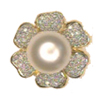
The Australian South Sea Pearl is unquestionably the rarest and finest cultured pearl in the world. No other pearl can equal its natural beauty and size. These high grade Australian Pearls are of such quality they do not require bleaching, tinting, dying or skinning. Their beauty will never fade because they are pure and untreated, ensuring a treasure that can be passed down from generation to generation.
Australian pearls range in size from 8mm up to 18mm, and come in many varied shapes and colours. The highly prized 'round' and 'drop' pearls are only two of the many natural shapes available. Baroque, circled, button and keshi pearls may be unique shapes, but all possess a beauty and style of their own. Like their 'round' and 'drop' counterparts, these pearls are naturally coloured silver, white, pink, golden or blue. Australian Pearls are highly prized and generally the most expensive.
South Sea Pearls
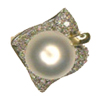 There are two basic groups of South Sea cultured pearls: white and black.
There are two basic groups of South Sea cultured pearls: white and black.
Pearls from the white group are primarily cultured in the northern waters of Australia, the Philippines and Indonesia. Their rarity and exceptional sizes, from 8 to 20mm, make them highly prized. Their colours range from white and silvery blue to pale gold - the golden or light-yellowish varieties abound in Philippine and Indonesian waters while white or silvery hues occur mainly in Australian waters.
Pearls from the black group, among which is the legendary black pearl of the South Pacific, are most frequently found over a wide area stretching from the Cook Islands, eastward through Tahiti to the Tuamotu Archipelago and the Gambier Islands in French Polynesia.
Tahitian Pearls 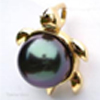
The cultured pearl of Tahiti is synonymous with magic and perfection. Most come from the atolls and lagoons of the South Pacific. They tend more toward drop shapes than round and vary in size from 7 to 15mm. They can be black, silver, dark or light grey. The rarest colour is "peacock green" - the greenish black colour of a peacock feather
Akoya Pearls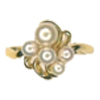
Considered the classic amongst cultured pearls, Akoya Pearls are primarily round or oval in shape and measure 2 to 10mm. They are cultured in southwestern Japan and China. Their colours range from pinkish white to creamy shades and silvery blue.
Mikimoto Pearls - Mikimoto Pearl Jewelery
If you know much about pearls, you've heard of the fabled Mikimoto brand. These cultured Akoya pearls are considered by many to be the Rolls Royce of pearls. Mikimoto is famous for selling very high end pearl jewelry at sometimes staggering prices. Sometimes mistaken for a type of pearl, Mikimoto is actually a brand name famous for selling Akoya pearls.
Keshi Pearls 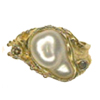
Possessing a whimsical charm entirely different to the perfectly round, large pearls, seedless keshi pearls arise spontaneously in the culture of Akoya, and South Sea pearls. These small freeform pearls make fascinating necklaces in colours ranging from silvery white to silvery grey.
Mabe Pearls 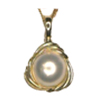
Mabé Pearls are attractive half pearls with beautiful, rainbow-coloured iridescence. The pearl was named after the mabé pearl oyster which is found mainly in the tropical seas of Southeast Asia and in the Japanese islands around Okinawa. Since the beginning of the century, many attempts had been made to cultivate round pearls from the mabé oyster but all had failed. However, in the 1950s hemispherical pearls (or 'half pearls' as they are more commonly known) were successfully cultivated. Today, most of these cultured half pearls do not come from the mabé oyster, but rather from the South Sea's silver-lipped oyster. Mabé pearls are also available in oval, cushion, drop and heart shapes.
Chinese Freshwater Pearls 
Chinese Freshwater Pearls are grown in an amazing variety of delicate shapes ranging from round and oval to button, drop and baroque. Their colours vary from pure white to orange and rosy violet.
Kasumiga Pearls
The Kasumiga is a new type of pearl that comes from a lake northeast of Tokyo. The mussels are a crossbreed between Japanese and Chinese freshwater mussels, and are implanted with round or flat seeds. Kasumiga Pearls glow in rosy hues of light to dark pink.
Majoica Pearls
MALLORCA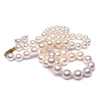
A well-known type of imitation pearls from the Spanish island of the same name. Also known as Majorcan pearls, they are quite popular in the USA. Many people believe them to be real pearls when, in fact, they are high quality imitations.
Terms such as Majoica should always be read in the same way as "imitation"
PEARL IDENTIFICATION: THE DIFFERENCE BETWEEN NATURAL, CULTURED, AND IMITATION
It's hard not to notice the sudden and large-scale reappearance of the popularity of pearls. They seem to be everywhere we look. However, there are so many different kinds of pearls that it's hard to determine what we're shopping for when we do decide to head out and buy one of these beautiful gems. Though there are many sub-categories, the place to begin when identifying pearls is among natural, cultured, and imitation pearls.
Most "real" pearl jewellery that we see in stores, jeweler shops, and other locations are cultured pearls. This means that they come from pearl farms, where mollusks have been encouraged by way of the right procedures and circumstances, to produce a pearl, or sometimes several pearls. In fact, cultured pearls are so universal, that the term "pearl" almost always refers to cultured pearls. Natural pearls and imitation pearls will be identified as such.
Natural Pearls are those which have been created as an accident within oysters and mussels in the "wild". Humans will not have had any part of their formation. However, these pearls are so rarely fished today, that the only real place to find a natural pearl is on a vintage or antique string.
Imitation pearls are simply stones that have been manufactured in order to make them look like pearls. They've never been inside a mollusk in their entire existence. Imitation pearls can be made of many different substances such as glass, plastic, and even shell, which are formed into spheres, and polished with items such as lacquer, fish scales, or plastic, for that pearly finish. It takes only a 10x lens to identify if they are imitation pearls. When in doubt, ask a jeweler you trust.
Of course, pearls aren't only identified by the terms natural, cultured, and imitation. The following are the different primary terms used by jewelers and other pearl distributors, to help you know what you're looking at:
Natural Pearls
A natural pearl is formed when a parasite or other foreign matter enters the body of the pearl producing mollusk. As a protective mechanism the mollusk deposits layers of nacre over the irritant. Over time the mollusk will continue to deposit layers of nacre and this is how the pearl is formed.
Oriental pearls – fished from sea water
River pearls – fished from inland rivers and lakes
Unfortunately in trade terminology the term Natural Pearls often refers to Non nucleated freshwater cultured pearls
Cultured Pearls
To form a cultured pearl, human intervention is required to assist in starting the pearl producing process in the mollusk. A piece of mantle tissue or a round bead is inserted into the mollusk and then the process of depositing layers of nacre around the irritant just as a natural pearl begins
Beaded Cultured Pearls – Akoya (from Japan), South Sea (large pearls from mainly Australia and the Philippines), Tahitian (large black pearls from Pacific Islands)
Non-Nucleated Cultured pearls – Freshwater (from rivers and lakes in Japan and China), Biwa (from a lake in Japan), Keshi (small freshwater pearls).
The Term Nun Nucleated Typically refers to freshwater pearls whereby mantle tissue from another mollusc is inserted to stimulate pearl growth. Refers to tissue-nucleated pearls.
Imitation Pearls
Terms such as Majoica should always be read in the same way as "imitation"
This is not a complete table, but it gives you an idea of the primary terms that you will see in the pearl marketplace.
PEARL GRADING: GETTING TO KNOW THE QUALITY OF A PEARL
If you're getting ready to buy pearls, it's important that you know what you're getting yourself into, so that you can recognize a deal when you see one. Price and quality are not as simple as shape or size, or even color. In actuality, there are 7 major elements to grading a pearl for quality and price. On top of this, different types of pearls have different grading systems that should also not be ignored when shopping for pearl jewellery.
The 7 most important elements to grading a pearl are:
- Luster – this is the first and most important definition for a pearl's beauty. Luster should be your primary focus when judging quality. To recognize finer luster, look at the clarity of images that are reflected in the pearl's surface. The closer to a mirror image you see, the better the luster. Pearls with fine luster also seem to glow warmly from within.
- Size – the larger the pearl, the rarer it is. The size of a pearl is measured across its diameter, and range from 8mm to the scarce 18mm.
- Shape – the rounder a pearl is, the rarer and more valuable it is. The goal is for a perfectly round pearl, though there is much more to pearls than an ideal orb. For example, Baroque pearls have a more linear shape which is quite popular. Therefore, you will want to look for categories of pearls in either "Classical" or "Baroque".
- Surface – the more flawless the surface of the pearl is, the higher it will be valued. However, a flawless pearl only comes about once in about every million, as pearls are the result of a natural process, and an oyster will usually leave some sort of unique mark on the finished pearl.
- Color – unlike the other factors, color has little influence on the actual value of a pearl, except in the case of popularity. Essentially, the color of the pearl you desire is a matter of personal taste. Traditionally, there is a rather consistent demand for the classic silvery white pearls and the glowing gold shades. The rarest and most desired are the white "rose" colored pearls.
- Weight – the weight of a pearl is not always provided, however finer jewelers will include it among their descriptions, especially in the case of larger pearls. Pearls are usually measured in carats, grains, or momme. Cultured pearls are generally weighed in momme, and natural pearls in grains.
- Natural/cultured – this is the difference between pearls that are found at sea, and those grown in pearl farms.
MIKIMOTO GRANDING SYSYTEM
Pearls are like fingerprints; each is unique. In 1974, Mikimoto established an industry standard with the first grading system in the U.S. for Akoya cultured pearls. Based on consumer demand, Mikimoto eventually adapted the system to grade South Sea cultured pearls.
Setting the Standard
While imitation systems exist, Mikimoto literally sets the standard for grading the quality of cultured pearls.
The Mikimoto pearl granding scale illustrates the system, with AAA representing the very highest quality.
Although no single factor can solely represent the worth of a pearl, luster and surface perfection are most important. Mikimoto graders spend years becoming experts in assessing these gems of the sea.
The Pearl Pyramid
The Pearl Pyramid represents the quantity and quality of all cultured pearls harvested in Japan. Only the best cultured pearls are deemed worthy to carry the Mikimoto name.
https://www.mikimotoamerica.com/about-pearl-jewelry/how-to-buy-pearls/mikimoto-grading-system/
Grading Systems
On top of these 7 rules of thumb, there are also established systems of grading that you can use to make your life much easier when you're selecting a pearl at a jeweler. These include the AAA-A System, and the A-D System (also called the Tahitian System).
- The AAA-A System – This system uses a grading scale from AAA to A, with AAA being the highest grade.
- The A-D System (Tahitian System) – grades pearls on a scale from A to D, with A being the highest, and anything below D being considered unacceptable for jewelry use.
The Above grading systems are at best widely accepted private terminology.
In india not many labs offer pearl identification or grading and where available is not cost effective.
